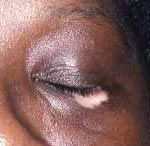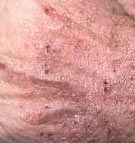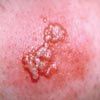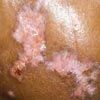Vitiligo, Scabies, and Herpes Simplex
An asymptomatic loss of pigment around the eyelids of several weeks' duration prompts a 53-year-old woman to seek evaluation. She has not started wearing any new eye makeup; her only medication is an antihypertensive.

Case 1:
An asymptomatic loss of pigment around the eyelids of several weeks' duration prompts a 53-year-old woman to seek evaluation. She has not started wearing any new eye makeup; her only medication is an antihypertensive.
What is your clinical impression?
A. Vitiligo.
B. Discoid lupus erythematosus.
C. Tinea versicolor.
D. Seborrheic dermatitis with postinflammatory hypopigmentation.
E. Perioral dermatitis.
(Answer on next page.)

Case 1: This patient has vitiligo, A, which is thought to be an autoimmune disease. The diagnosis is made clinically and can be confirmed by the absence of melanocytes on skin biopsy. Management remains elusive; some patients respond to topical corticosteroids or tacrolimus ointment, but the course of the disease is unpredictable.
Discoid lupus erythematosus produces scarring. Tinea versicolor affects the trunk. Seborrheic dermatitis can produce hypopigmentation but not depigmentation. Perioral dermatitis produces erythematous papules, not depigmentation.

Case 2:
A 58-year-old man has a pruritic rash that erupted on his hands 6 weeks ago and spread to the rest of his body, including the genitalia. The pruritus is so intense that it keeps him awake at night. He thinks that the rash developed after he did some yard work. He has not started any new medications.
What does this look like to you?
A. Scabies.
B. Contact dermatitis.
C. Tinea pedis with id reaction.
D. Dyshidrotic hand eczema.
E. Atopic dermatitis.
(Answer on next page.)

Case 2: Microscopic analysis of skin scrapings confirmed the diagnosis of scabies, A. It was subsequently determined that the patient had acquired the infestation from his grandchildren. All affected and exposed family members were successfully treated with permethrin.
Contact dermatitis is unlikely because the distribution would be unusual without an exposure history. Tinea infections that result in id reactions are usually dyshidrotic on the hands and more eczema-like elsewhere. Dyshidrotic outbreaks usually consist of intensely pruritic vesicles on the palms and sides of the fingers. Atopic dermatitis of new onset would be unusual in a middle-aged person; it would be more eczematous and not involve the genitalia.

Case 3:
For 3 days, a 28-year-old woman has had a tender eruption on her posterior right thigh. She has no history of a similar eruption. She is otherwise healthy but had seasonal allergies as a child. Recently, she has started using new brands of soap and shaving cream.
Can you identify this eruption?
A. Staphylococcal infection.
B. Fixed drug eruption.
C. Herpes simplex virus infection.
D. Contact dermatitis.
E. Nummular eczema.
(Answer on next page.)

Case 3: A culture identified herpes simplex virus type 2, C. Treatment with oral antiviral antibiotics was started. The patient was counseled about being evaluated for other sexually transmitted diseases and the ramifications of genital herpes infections.
Bullous impetigo from a staphylococcal infection usually produces more fragile blisters. Fixed drug eruption is a possibility if a relevant history can be obtained; otherwise, a biopsy would confirm the diagnosis. Contact dermatitis is unlikely because of the lack of exposure history and the absence of pruritus. Nummular eczema is pruritic and does not form blisters.

Case 4:
During the past several weeks, a 33-year-old man has noticed a loss of pigment on his face. The area is slightly pruritic. He has a history of childhood allergies but is otherwise healthy and has not started any new medications.
What is the likely diagnosis?
A. Vitiligo.
B. Discoid lupus erythematosus.
C. Sarcoidosis.
D. Pityriasis alba.
E. Seborrheic dermatitis with postinflammatory hypopigmentation.
(Answer on next page.)

Case 4: A biopsy confirmed the diagnosis of discoid lupus erythematosus, B. This condition is more common in younger than older adults and affects women twice as frequently as men. Atrophy and scarring with loss of pigment are common findings; erythema is seen in the early stages. The condition is treated with topical corticosteroids and oral antimalarial agents.
None of the other entities in the differential produce scarring; in addition, vitiligo is not erythematous.